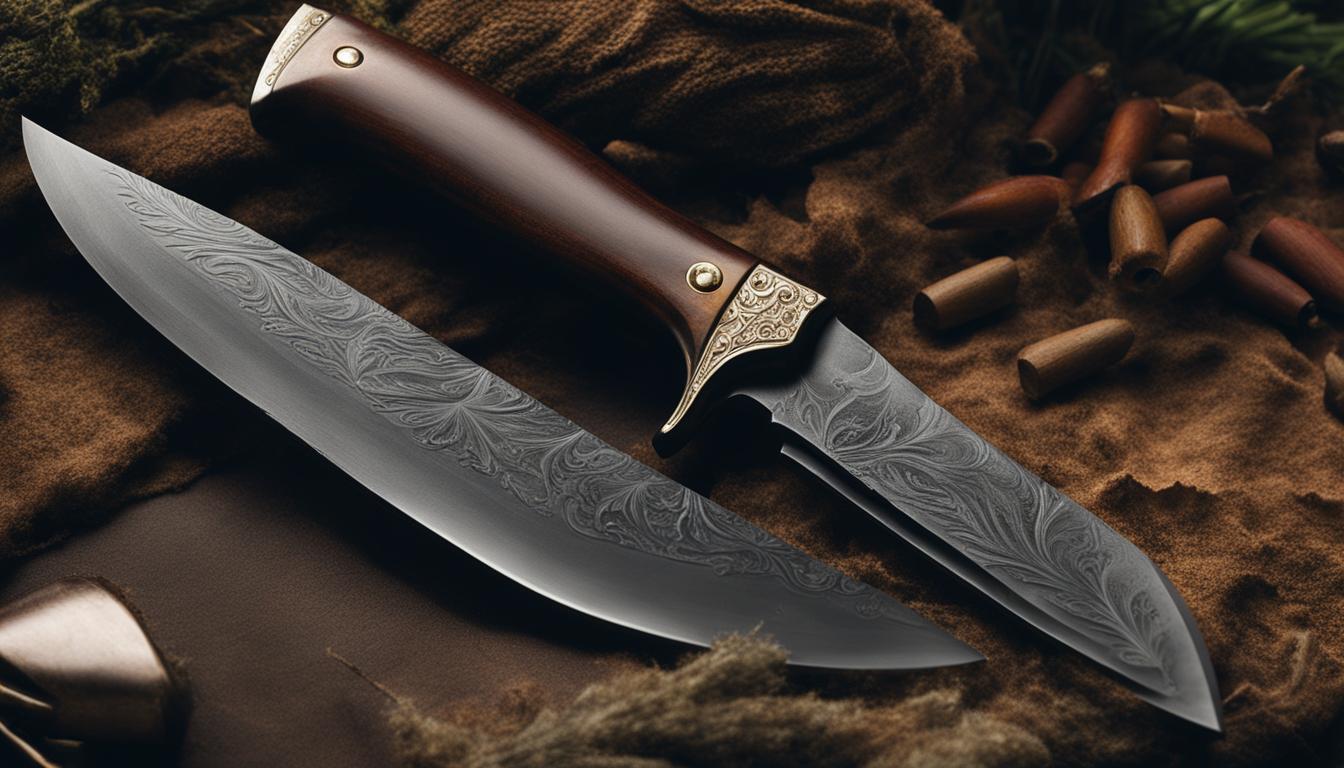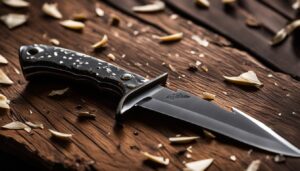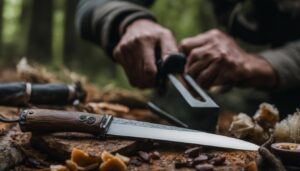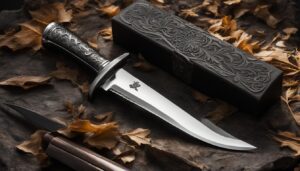The fixed blade knife is the most practical hunting tool for outdoorsmen. American craftsmen and women produce some of the finest fixed blades. Factors such as intended use, local environment, hand size, and personal preference determine the best knife for each individual. Blade geometry, heat treatment, and personal preference in blade design are more important than the steel composition. All steels are a compromise between edge retention, toughness, and rust resistance. To learn more about steels, KnifeSteelNerds.com, run by a PhD steel metallurgist, is a reliable resource. The best approach is to invest in high-quality American-made knives that will last for decades.
Key Takeaways:
- Choose the right knife based on factors such as intended use, local environment, hand size, and personal preference.
- Blade geometry, heat treatment, and design are more important than steel composition for edge retention.
- Invest in high-quality American-made knives for long-lasting performance.
- Consider factors such as edge retention, toughness, and rust resistance when selecting a knife.
- KnifeSteelNerds.com is a reliable resource for learning more about steels.
Tips for Blade Maintenance and Preservation
Proper blade maintenance is crucial for maximizing edge retention and ensuring your hunting knife remains in optimal condition. By following these blade maintenance tips, you can extend the lifespan of your knife and enjoy its peak performance during every outdoor adventure.
Clean the Blade After Each Use
After using your hunting knife, it’s essential to clean the blade thoroughly. Use a mild detergent or warm soapy water to remove dirt, blood, and any other debris. Gently scrub the blade with a soft cloth or brush, paying attention to the area near the cutting edge. Rinse the blade with clean water and dry it thoroughly to prevent corrosion.
Apply a Thin Layer of Oil
To protect the blade from moisture and rust, apply a thin layer of oil or lubricant after cleaning and drying. This will create a barrier between the metal and any potential corrosive elements. You can use specialized knife oil or even food-grade mineral oil. Apply a few drops to a clean cloth and rub it onto the blade, ensuring even coverage. Avoid using too much oil, as it may attract dirt or become sticky over time.
Store in a Dry Environment
When your hunting knife is not in use, it’s important to store it in a dry environment. Moisture can lead to rust and corrosion, compromising the blade’s edge retention. Keep your knife in a sheath or a dry box to protect it from humidity and temperature fluctuations. If storing multiple knives, ensure they are not in contact with each other, as this can cause blade damage.
Regularly Sharpen the Blade
To maintain a sharp edge, it is necessary to regularly sharpen your hunting knife. Depending on the frequency of use, you may need to sharpen the blade after every few outings or whenever you notice a decrease in cutting performance. Use a high-quality sharpening tool that suits your skill level and preference, such as a whetstone or a guided sharpening system. Take your time and follow the manufacturer’s guidelines for achieving the correct sharpening angle.
Avoid Misuse and Tasks Outside its Design
While it may be tempting to use your hunting knife for other tasks, it is important to avoid misuse. Using the knife for tasks it’s not designed for can put excessive stress on the blade, leading to chipping, dulling, or even breakage. Always prioritize the knife’s intended purpose and opt for specialized tools for other tasks.
By following these blade maintenance tips, you can ensure your hunting knife remains in top condition and maintains excellent edge retention. A well-maintained blade will enhance your hunting experience and provide the reliability you need in the great outdoors.
Knife Sharpening Strategies for Edge Preservation
Properly sharpening your hunting knife is essential for maintaining edge retention and ensuring optimal performance. By following these knife sharpening strategies, you can prolong the life of your blade and enhance its cutting ability:
1. Choose the Right Sharpening Angle
Different knives have different recommended sharpening angles, so it’s important to consult the manufacturer’s guidelines. Using the appropriate angle will help you achieve a sharp edge without compromising the blade’s structural integrity.
2. Select the Appropriate Sharpening Tool
There are several sharpening tools available, including whetstones, sharpening steels, and guided sharpening systems. Each tool has its own advantages, so choose one that suits your skill level and personal preference.
3. Maintain a Consistent Sharpening Motion
Whether you prefer a circular or linear motion, it’s important to maintain a steady pace and apply even pressure to the blade. This ensures that the entire cutting edge is properly sharpened and reduces the risk of creating an uneven edge.
4. Test the Sharpness Frequently
While sharpening, it’s crucial to frequently test the sharpness of the blade. This can be done by carefully running your finger or a piece of paper along the edge. Adjust your sharpening technique as needed to achieve your desired level of sharpness.
5. Consider Using a Strop
After sharpening, using a strop can help refine the blade’s edge and achieve a razor-sharp finish. Stropping removes any remaining burrs and polishes the edge, resulting in enhanced cutting performance.
By employing these knife sharpening strategies, you can maintain the edge retention of your hunting knife and ensure that it remains sharp and reliable throughout your outdoor adventures.
Top Hunting Knife Edge Preserving Techniques
When it comes to maximizing the edge retention of your hunting knife, there are several techniques you can employ. By following these practices, you can ensure that your knife stays sharp and reliable throughout your outdoor adventures.
Careful Usage
One of the most important edge preserving techniques is to use your knife for its intended purpose. Avoid using it for tasks that may put excessive stress or strain on the blade. By using your knife only for the tasks it’s designed for, you can prevent unnecessary wear and tear on the cutting edge.
Mindful Cutting Techniques
When cutting through tough materials, it’s important to use controlled and deliberate strokes. This minimizes the risk of damage to the cutting edge and helps preserve the sharpness of your knife. Take your time and apply consistent pressure to ensure clean and efficient cuts.
Regular Inspections
Make it a habit to regularly inspect your knife for any signs of damage or wear. Check the blade for chips, dents, or any other issues that may affect its performance. Address any issues promptly to prevent further damage and preserve the edge of your knife.
By employing these edge preserving techniques, you can extend the lifespan of your hunting knife and ensure that it remains a reliable tool in the field.
Conclusion
The preservation of hunting knife edge retention is a crucial aspect for every avid outdoorsman. By following a few key techniques, hunters can ensure that their knives remain sharp and efficient throughout their outdoor adventures.
First and foremost, proper blade maintenance is essential. Cleaning the blade after each use to remove dirt, blood, and moisture, drying it thoroughly to prevent corrosion, and applying a thin layer of oil or lubricant for protection are all vital steps to preserve the edge.
Additionally, mastering the art of knife sharpening is key. Choosing the appropriate sharpening angle, using the right sharpening tool, maintaining a consistent sharpening motion, and testing the sharpness frequently are all strategies that contribute to edge retention.
Lastly, practicing edge preserving techniques, such as using the knife for its intended purpose, avoiding cutting on hard surfaces, and regularly inspecting the blade for any signs of damage, can significantly extend the lifespan of a hunting knife’s edge.
In conclusion, by combining blade maintenance tips, proper sharpening strategies, and edge preserving techniques, hunters can ensure that their knives remain sharp and efficient for a superior hunting experience. A well-preserved knife is a reliable and long-lasting tool in the wilderness. So remember, prioritize blade care and maintenance to maximize hunting knife edge retention.
FAQ
What factors determine the best hunting knife for an individual?
Factors such as intended use, local environment, hand size, and personal preference determine the best knife for each individual.
What is more important than the steel composition for a hunting knife?
Blade geometry, heat treatment, and personal preference in blade design are more important than the steel composition.
Are all steels a compromise between edge retention, toughness, and rust resistance?
Yes, all steels are a compromise between edge retention, toughness, and rust resistance.
Where can I find reliable resources to learn more about steels for hunting knives?
KnifeSteelNerds.com, run by a PhD steel metallurgist, is a reliable resource to learn more about steels for hunting knives.
What are some tips for caring for hunting blades?
Clean the blade after each use, dry it thoroughly, apply a thin layer of oil or lubricant, store it in a dry environment, regularly sharpen the blade, and avoid using the knife for tasks it’s not designed for.
How can I maximize the edge retention of my hunting knife?
Use the appropriate sharpening angle, choose the right sharpening tool, maintain a consistent sharpening motion, test the sharpness frequently, and consider using a strop to refine the edge after sharpening.
How can I preserve the edge of my hunting knife during use?
Use the knife for its intended purpose, avoid cutting on hard surfaces, take care when cutting through tough materials, regularly inspect the blade for damage or wear, and carry a touch-up sharpener or honing rod with you on your hunting trips.
How should I protect my hunting knife when not in use?
Store the knife in a sheath or carrying case when not in use to prevent accidental damage and keep the blade in optimal condition.





